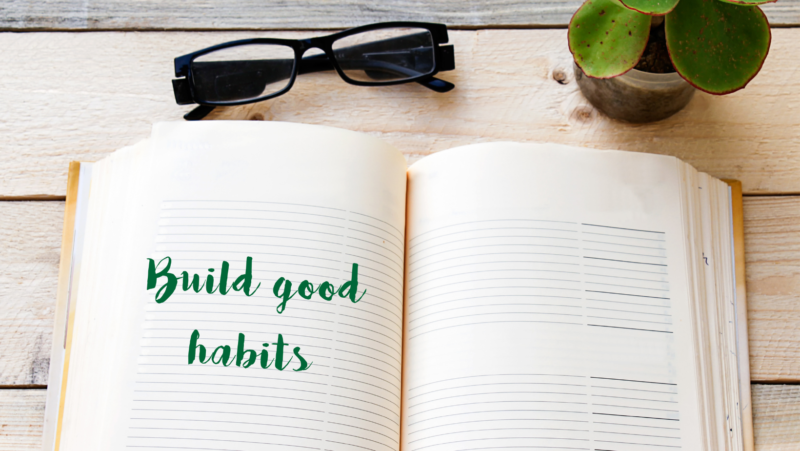Blog Short #113: 5 Habits to Take Into the New Year

It’s that time of year when we stop to think about where we are, where we’ve been, and where we want to go. As we head into the new year, I want to offer some ideas to help you ponder those questions and make new plans.
Today we’re starting with five habits aimed at keeping you in a good place emotionally, regardless of what new goals you want to accomplish in 2023.
Next week I’ll talk about goal-setting and strategies to achieve them, and the following week tackle momentum and motivation.
I think it’s always helpful to get into the right mindset before figuring out what you want to do. In a phrase, focus on how you “be” before what you “do.”
Let’s dive in.
1. Start a daily gratitude journal.
If you’ve never tried this, please do. I’ve been doing this for at least ten years, and I never fail to be impressed with how much it positively impacts my daily mindset.
It’s very simple. Every day, write out ten things you’re grateful for. If ten sounds too much, do five or even three, but whatever you choose, be consistent.
This works best if it’s a ritual you do the same way and same time every day. I think morning is best because it sets you up for the day and resets you if you wake up grumpy.
I can be in a lousy mood, and by the time I finish that tenth item, my perspective’s shifted. I’m not exaggerating. I’m always surprised by the shift.
I type into an iPad in a format I have set up. You can write it by hand or type it. Some people say they get more out of writing by hand. Do whatever works for you.
You can read a longer article by clicking here if you’d like more detailed instructions on how to do this.
2. Listen more than you talk.
This is one of those habits that yields profound benefits. Here’s how to do it:
Whenever you’re having a conversation with someone, make a pointed effort to give your full attention to the other person, and do your best to understand fully what they’re trying to tell you before you respond. Listen for their feelings as well as thoughts, and ask yourself what they need or want from you. What do they want you to hear?
If you listen to understand this way, your communication with everyone will go more smoothly and enhance your relationships.
That doesn’t mean you shouldn’t say what’s on your mind, but always seek to understand and validate the other person before you do that. You’ll get better receptivity that way. This is especially helpful when subjects are contentious or heavy.
Secondly, expand your listening to broader situations. For instance, in a meeting or social setting, be quiet and take in what people are saying and thinking before you start talking. By listening objectively and hearing, you get a feel for the emotional pulse in a room. It’s very beneficial, especially when you need to be strategic with your communication.
It’s less stressful too, because:
- You get more information.
- You don’t have to be “on” right off the bat.
- When you do interact, you’re likely to be more effective with what you say and how you say it.
Most importantly, listening connects you more fully with others.
3. Practice empathy.
This one comes next because it goes along with listening.
When you attend to someone the way I’ve just described, you’re being empathetic as you seek to understand and connect.
You can also extend your empathy more broadly. When you’re anywhere, look around at people and recognize that each person you see has their own life, living circumstances, issues they struggle with, ways of thinking, backgrounds, and experiences.
When you look at someone closely, and especially at their eyes, you can see a lot. Each person you look at that way becomes more human to you and creates greater empathy. It changes how you interact with and treat people. It makes you more kind.
Sometimes I wonder what someone’s life is like. I might notice the lines in their face, the burdens they carry, or even the happiness and delight they express.
This is true even of people I might heavily disagree with or not want to spend time with, but the common humanity helps create acceptance and a persistent knowing that we’re all in this together.
We tend to narrow in. Practicing this type of empathy pushes you back out and keeps you open.
4. Set boundaries.
So didn’t I just tell you to be more empathetic and spread your concern wider? Yes, I did, but you can do that while also setting boundaries that are in your best interest and preserving your best self.
Boundaries don’t need to be harsh or negative. Setting a boundary means you value both yourself and the other person or persons involved. It means adhering to basic rules of behavior that are good for everyone.
If you’re already good at setting boundaries, great! But most people struggle with them, and sometimes throughout their whole lives.
Take an inventory over the next couple of weeks and decide what new boundaries you need to set.
- Where are you being taken advantage of?
- What kinds of behaviors are you engaging in that don’t really reflect your values?
- Who are you regularly rescuing that needs to stand on their own two feet?
- Are you overworking and not attending to your own basic needs?
Ask those questions, make a list, and set one new boundary at a time. You can read this article for more help.
5. Create an emotional reset ritual.
An emotional reset ritual is something you do whenever you find yourself overwhelmed, anxious, worried, overdone, emotionally upset, or off-kilter.
I’ll give you an example of mine and then help you figure out how to set up yours. Mine consists of four steps.
- I stop whatever I’m doing or thinking and say to myself, “You need to reset.”
- I do one set of square breathing. Get the instructions here.
- Next, I repeat a ready-made mantra. I have several I use for different types of situations. One of them is, “All problems are solvable. I can figure out what to do.” Another one is, “This isn’t an issue I can solve today. Put it away for now, and get back to work.” Another is, “I can do this. I just need to calm down, take a moment, and do it.” That last one works best with interruptions like flat tires or your dog rolling in something awful as you’re going out the door to work.
- Last, I shift gears and move forward.
For some people, feeling overwhelmed is the worst. For others, transitions or unexpected problems cause the most trouble. You know yourself, so create a ritual that best fits what you think you’ll need.
Get tuned into your particular soft spots, and set up a routine to speak to those. The mantras are especially helpful if you take the time to create ones that will fit those crucial situations. You can even put them in your phone to remind you when you need them.
Last Note
This is the last blog before Christmas. As mentioned in the intro, on the 26th, I’ll address goals and methods for accomplishing them, and on January 2nd, I’ll talk about how to maintain your momentum as you move into the New Year. For now, work on your mindset!
I wish you a wonderful holiday!
All my best,
Barbara




 Photo by
Photo by 

 Today I’m going over two of them that paint life in a negative light. If you’re familiar with Saturday Night Live, you’ve likely seen an older skit with a character named “Debbie Downer” played by Rachel Dratch. She’s the poster child for these two distortions!
Today I’m going over two of them that paint life in a negative light. If you’re familiar with Saturday Night Live, you’ve likely seen an older skit with a character named “Debbie Downer” played by Rachel Dratch. She’s the poster child for these two distortions!
